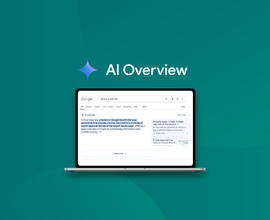5 Use Cases to Optimize Your Content Workflows with AI
Not all AI-powered content workflows are created equal. Some methods offer you new and innovative ways to make your content workflows more efficient. While others wind up making more work for you down the line. Before you waste your resources with low-impact AI-powered processes, explore ways to streamline your entire content lifecycle with the help of AI.
In a very short time, generative AI has changed the way we create content, and that’s not going to stop anytime soon. However, simply leveraging AI isn’t enough to create high-value content that helps your target audience. To do that and maximize your content performance, you can’t just publish lightly edited AI-generated content.
You need to leverage AI as a sidekick to maximize your content processes. But what does that actually mean in practice? Let’s dive into a variety of use cases for implementing AI within all five workflows of the content lifecycle to boost efficiency and make your content more helpful to your audience.
What is content workflow optimization?
First and foremost, let’s tackle what we mean when we talk about content lifecycle or content workflow optimization. Content optimization is the process of using performance data to understand the impact of your content and leveraging those insights to create more helpful and valuable content for your audience.
In practice, content workflow optimization consists of processes like keywordKeyword
A keyword is what users write into a search engine when they want to find something specific.
Learn more research, content outlining, content promotion, and, of course, lots of writing and rewriting. Altogether, it’s an important but time-consuming process. That said, many of those workflows can be automated or at least streamlined with the help of AI.
Why is implementing AI in your content workflows important?
Let’s talk about what you stand to gain from incorporating AI into your content workflows.
For starters, it will save you and your team time and resources. By automating certain workflows, like creating content outlines and scheduling social media posts, content writers can focus on more impactful workflows like Identifying new topics, finding opportunities to improve existing articles, and actually creating new content.
AI can also help you create more impactful content that resonates with your audience. AI accelerates tedious processes, helping you quickly uncover new viewpoints, topics, and pain points to speak to within your content.
Helpful and impactful content is the name of the game regarding organic search. If you create content that helps your intended audience solve their problems, that will lead to improved search engineSearch Engine
A search engine is a website through which users can search internet content.
Learn more rankingsRankings
Rankings in SEO refers to a website’s position in the search engine results page.
Learn more, organic traffic, engagement, and conversions down the line.
So, how do you leverage AI within your content workflows?
Recommended AI tools & solutions
To maximize your content workflows with AI, you’ll need the right tools. The market is awash with hundreds, if not thousands, of AI-powered tools and solutions that claim to be the missing piece you’re looking for.
Now, we can’t say for sure which ones will work best for you and your particular goals, but we will dive into a few of the tools we’ve been using to help automate and accelerate some of our content workflows.
AI Solution | Description | |
|---|---|---|
Chatbots | Chatbots like Claude and ChatGPT can carry on a conversation with you, answer direct questions, and complete certain tasks to help make your processes more efficient. | |
Proofreading | No matter how many times you reread something, you may still miss spelling and grammar errors. Proofreading AI, like Grammarly instantly find the mistakes you miss, and suggest copy improvments. | |
Content outlining & creation | Conductor’s Content Guidance & Writing Assistant | Solutions like Conductor’s Content Guidance leverages real-time SERP data to offer insights on what topics to target, and how the top-ranking content structured and wrote their content. While Writing Assistant uses AI as well as SERP data to create outlines for content and suggest copy elements to improve content creation efficiency. |
Social media management | Social media management platforms like Sprout Social use AI to help users analyze engagement patterns to quickly identify areas for improvement. These tools can also be used to automate various manual social media tasks. |
Where AI fits in your content workflows
When you think about AI within content workflows, it’s easy to associate it with simple content creation. After all, generative AI tools can create a multi-thousand-word blog post in seconds. But really, AI offers opportunities to boost workflows throughout your entire content lifecycle.
Before diving into AI applications within your content lifecycle, let’s review the content lifecycle.
The content lifecycle can be broken down into these simple workflows:
- Content ideation
- Content research
- Content creation
- Content analysis
- Content optimization
Common limitations of AI
Before you start implementing AI into each of your content workflows, let’s talk about AI’s limitations and where it can sometimes do more harm than good. For starters, it’s important to remember that AI is still learning and growing, and there’s a lot of room for improvement.
With this in mind, AI sometimes has “hallucinations” and provides either misleading or outright incorrect information. Chatbots are also bound by the content on which they were trained. AI models are fed millions and millions of pieces of content from around the web, and depending on the quality of that content, chatbots may show biases or an increase in hallucinations.
All of this is to say that when you use AI power, it’s imperative that you still use human expertise to thoroughly review the output to make sure the content is correct, unbiased, and meets the standards of your brand. The longer a piece of content is, the greater the chances are that AI will slip up and include low-quality copy or information, which is why we recommend keeping the output from AI on the shorter side and letting your human content writers handle long-form copy creation.
In short, no matter how you decide to leverage AI, you need to make sure that a thorough review process is a part of that workflow.
FAQs
How does Google view AI content?
Don’t worry too much about how Google views AI content. You’re not writing content for Google. You’re writing content to help your audience. If your content is helpful and valuable to readers, it will rank well on Google.
That said, completely AI-written content most likely won’t provide the same experience, guidance, and perspective that a human can, which may cause it to suffer in the rankings or, in extreme cases, could lead to a manual action from Google . This type of low-quality AI-generated content was recently targeted, and large amounts of it were removed from SERPs as part of Google’s recent Core and Spam updates.
Google said of the update: “We expect that the combination of this update and our previous efforts will collectively reduce low-quality, unoriginal content in search results by 40%.”
In short, it’s imperative to thoroughly proofread and revise AI content before publishing to ensure it’s as helpful as possible.
Can I prompt AI to include more keywords in my content?
Yes, you can. But you shouldn’t . Stuffing keywords into your content should not be a goal, and it really hasn’t worked as a practice in well over a decade. Focus on optimizing your content for user intent rather than the number of keywords you use, and the results will be there. Google promotes helpful content. Help your users by answering their questions rather than relying on arbitrary keywords, and you will drive strong results.
Summarizing content workflow optimization with AI
It’s easy these days to pay lip service to optimizing your workflows with AI. AI is a cool new toy that everyone wants to use. But to maximize your use of AI and your output, you need to be strategic in leveraging AI rather than using it just to do it.
Try out the AI-powered content workflow optimization use cases we’ve laid out in our downloadable guide and set yourself up for a streamlined, efficient, and impactful content strategy. Small changes to improve efficiency can pay big dividends down the line, so dive into new strategies to help you take advantage of the ever-expanding world of AI.







